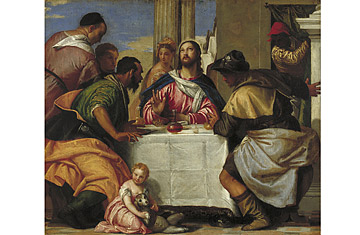
Supper at Emmaus by Paolo Veronese, part of the Boston Museum of Fine Arts' "Rivals in Renaissance Venice" show
Art may not have its own Super Bowl — a good thing, that — but it never lacks for head-to-head competitions. Picasso and Matisse played show-me-what-you-got for decades, continually rolling out works meant to show up the other guy. Leonardo, Michelangelo and Raphael all kept a cool eye on each other. And there's a brisk little chapter in the history of Abstract Expressionism that could fairly be called De Kooning vs. Pollock.
And then there was Venice in the 16th century, where three powerfully gifted men set the art of painting on a new course while engaging each other in an intricate call-and-response, some of it admiring, some of it anything but. The complex dynamic of that decades-long game is charted with authority and lots of cinquencento dazzle in "Titian, Tintoretto, Veronese: Rivals in Renaissance Venice," an abundant show at the Boston Museum of Fine Arts. Conceived and co-organized by Frederick Ilchman, a Boston MFA curator, with Jean Habert of the Louvre, it runs through August 16 then moves to Paris, its only other venue. (See pictures of the new show at the Boston MFA.)
Venice in the 1500s was a splendid and self-regarding republic on the cusp of a long decline, in its last years as a genuine regional power but arriving at its supreme moment as a center of the Western imagination. The first flowering of the Renaissance had taken place in Florence and then Rome, by way of art that emphasized clear drawing and firmly contoured forms — disegno, as the theorists of the day called it. But by the first decades of the 16th century, Venice had developed a mighty alternative, under the shorthand term colorito, building forms through a multitude of gentle, broadly applied brushstrokes and warm colors.
Titian was the pivotal figure in all this. Born on the mainland in 1488, he was brought to Venice as a child and eventually apprenticed with the most poised and elegant of Venetian masters, the brothers Gentile and Giovanni Bellini. In the Bellini workshop he would have learned to render the many formats of Christian iconography — the Annunciation, the Nativity, the Crucifixion — in the serene, harmonious manner that was Bellini's trademark.
Serene, but a little static and ceremonious. The Virgin and Child with Saints, a panel painting from the Bellini workshop that was done in the years around 1505 when Titian worked there, is typical. Six gently realized figures are aligned simply in a row toward the viewer, barely acknowledging one another. The genre is called a sacra conversazione — sacred conversation — but nobody in this picture seems to be on speaking terms. Less than a decade later, in Virgin and Child with Saint Catherine, Saint Dominic, and a Donor, Titian, by then in charge of his own studio, brought the Virgin into a persuasively rendered meadow that was also a force field of charged glances with the pious men adoring her.
Titian could do it all. He could make the conventions of Renaissance art more intimate and candid, or he could enlarge them, launching the Virgin theatrically into the heavens or planting her throne high among spectacular settings of classical arches and columns. It matters that he came of age just as artists were abandoning wood panels in favor of stretched canvas — especially in Venice, a maritime power where ship canvas was everywhere — and turning away from fresco or egg tempera to the relatively new and more pliant medium of oil paint. Drag a loaded brush over the textured surface of a canvas, and a whole range of sensual effects are possible. The feathery plush of a fur collar, the glint of light on armor, the nap of rough cloth — they could all be suggested by oil in ways that tempera couldn't quite do.
